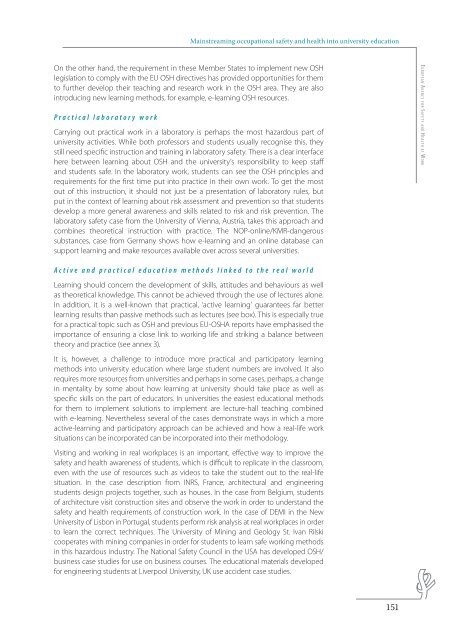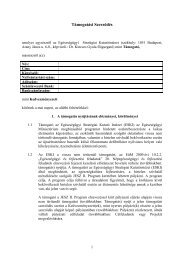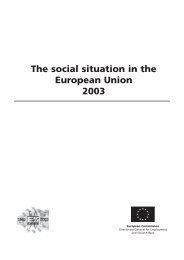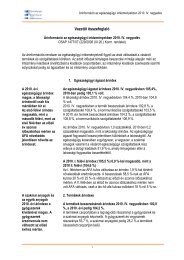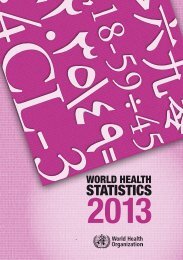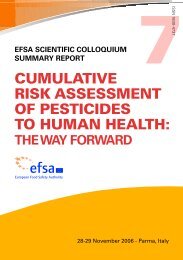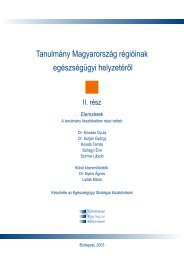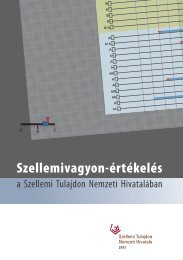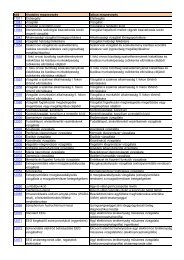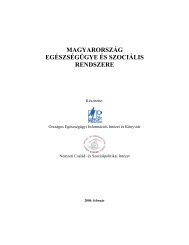Mainstreaming occupational safety and health into university ...
Mainstreaming occupational safety and health into university ...
Mainstreaming occupational safety and health into university ...
Create successful ePaper yourself
Turn your PDF publications into a flip-book with our unique Google optimized e-Paper software.
<strong>Mainstreaming</strong> <strong>occupational</strong> <strong>safety</strong> <strong>and</strong> <strong>health</strong> <strong>into</strong> <strong>university</strong> educationOn the other h<strong>and</strong>, the requirement in these Member States to implement new OSHlegislation to comply with the EU OSH directives has provided opportunities for themto further develop their teaching <strong>and</strong> research work in the OSH area. They are alsointroducing new learning methods, for example, e-learning OSH resources.Practical laboratory workCarrying out practical work in a laboratory is perhaps the most hazardous part of<strong>university</strong> activities. While both professors <strong>and</strong> students usually recognise this, theystill need specific instruction <strong>and</strong> training in laboratory <strong>safety</strong>. There is a clear interfacehere between learning about OSH <strong>and</strong> the <strong>university</strong>’s responsibility to keep staff<strong>and</strong> students safe. In the laboratory work, students can see the OSH principles <strong>and</strong>requirements for the first time put <strong>into</strong> practice in their own work. To get the mostout of this instruction, it should not just be a presentation of laboratory rules, butput in the context of learning about risk assessment <strong>and</strong> prevention so that studentsdevelop a more general awareness <strong>and</strong> skills related to risk <strong>and</strong> risk prevention. Thelaboratory <strong>safety</strong> case from the University of Vienna, Austria, takes this approach <strong>and</strong>combines theoretical instruction with practice. The NOP-online/KMR-dangeroussubstances, case from Germany shows how e-learning <strong>and</strong> an online database cansupport learning <strong>and</strong> make resources available over across several universities.E u r o p e a n Ag e n c y f o r Sa f e t y a n d He a l t h a t Wo r kActive <strong>and</strong> practical education methods linked to the real worldLearning should concern the development of skills, attitudes <strong>and</strong> behaviours as wellas theoretical knowledge. This cannot be achieved through the use of lectures alone.In addition, it is a well-known that practical, ‘active learning’ guarantees far betterlearning results than passive methods such as lectures (see box). This is especially truefor a practical topic such as OSH <strong>and</strong> previous EU-OSHA reports have emphasised theimportance of ensuring a close link to working life <strong>and</strong> striking a balance betweentheory <strong>and</strong> practice (see annex 3).It is, however, a challenge to introduce more practical <strong>and</strong> participatory learningmethods <strong>into</strong> <strong>university</strong> education where large student numbers are involved. It alsorequires more resources from universities <strong>and</strong> perhaps in some cases, perhaps, a changein mentality by some about how learning at <strong>university</strong> should take place as well asspecific skills on the part of educators. In universities the easiest educational methodsfor them to implement solutions to implement are lecture-hall teaching combinedwith e-learning. Nevertheless several of the cases demonstrate ways in which a moreactive-learning <strong>and</strong> participatory approach can be achieved <strong>and</strong> how a real-life worksituations can be incorporated can be incorporated <strong>into</strong> their methodology.Visiting <strong>and</strong> working in real workplaces is an important, effective way to improve the<strong>safety</strong> <strong>and</strong> <strong>health</strong> awareness of students, which is difficult to replicate in the classroom,even with the use of resources such as videos to take the student out to the real-lifesituation. In the case description from INRS, France, architectural <strong>and</strong> engineeringstudents design projects together, such as houses. In the case from Belgium, studentsof architecture visit construction sites <strong>and</strong> observe the work in order to underst<strong>and</strong> the<strong>safety</strong> <strong>and</strong> <strong>health</strong> requirements of construction work. In the case of DEMI in the NewUniversity of Lisbon in Portugal, students perform risk analysis at real workplaces in orderto learn the correct techniques. The University of Mining <strong>and</strong> Geology St. Ivan Rilskicooperates with mining companies in order for students to learn safe working methodsin this hazardous industry. The National Safety Council in the USA has developed OSH/business case studies for use on business courses. The educational materials developedfor engineering students at Liverpool University, UK use accident case studies.151


